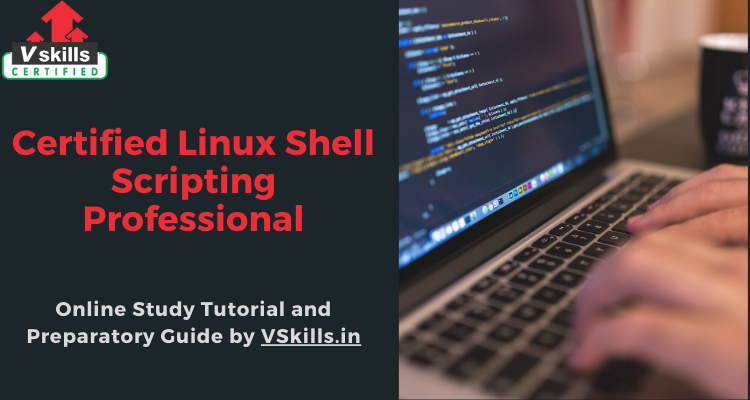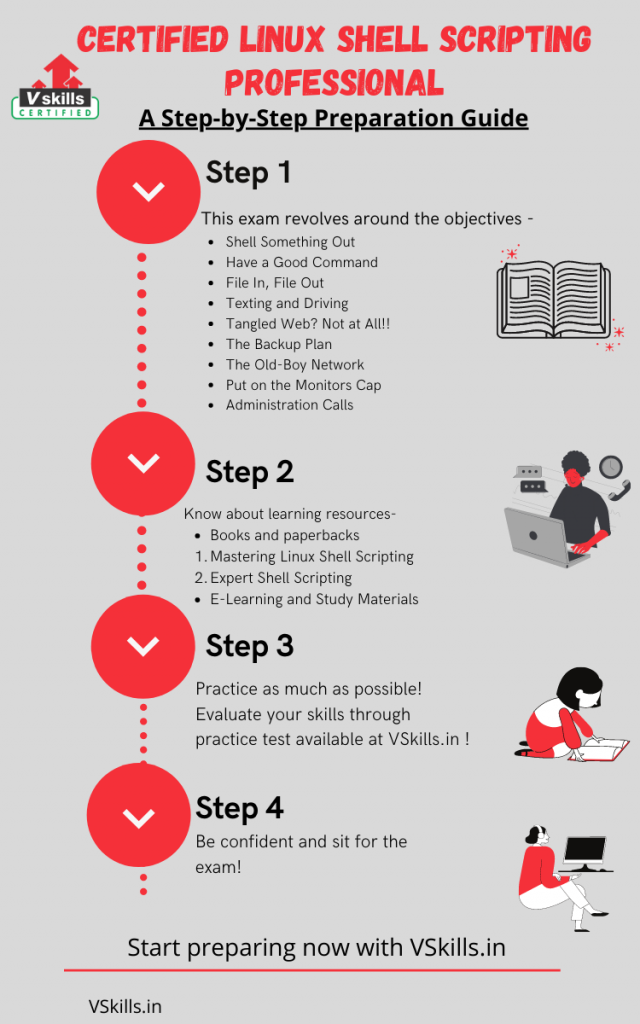
Certifications are a way to validate your skills and stand out in the crowd. The Linux Shell Scripting remains one of the most powerful tools on a computer system yet a large number of users are unaware of how much can be accomplished with it. Using a combination of simple commands, you will see how to solve complex problems in day-to-day computer usage.
Well, these kinds of certifications can be quite challenging and may require a lot of effort along with strong analyzing skills to relate things to actual business scenario. This certificate will add a star skill to your resume and will help you climb the corporate ladder. Also, this will also depict more professionalism and dedication towards your aim. Let us know about the exam in detail.
Why to take this certification?
This online course will take you through useful real-world examples to make your daily life easy when working with the shell. It will also help you to learn, how to effectively use the shell to accomplish complex tasks with ease. Starting with the basics of the shell, you will learn simple commands and their usages, allowing you to perform operations on different kinds of files.
This is an excellent online course on solving day-to-day problems using the shell and a few powerful commands together to create solutions.
Intended Audience
Job seekers looking for employment in various IT companies, PSUs or MNCs. Certification in Linux shell scripting will benefit professionals working in administration and students across various Industries. IT companies, MNCs, Consultancies hire Linux Shell Scripting professionals for administration related opportunities. Companies employing Linux shell scripting include Capgemini, JP Morgan Chase, TCS, Wipro, Zensar, Accenture, Infosys etc.
How It Works
- Select Certification & Register
- Receive a.) Online e Learning Access (LMS) b.) Hard copy – study material
- Take exam online anywhere, anytime
- Get certified & Increase Employability
Test Details
- Duration: 60 minutes
- No. of questions: 50
- Maximum marks: 50, Passing marks: 25 (50%).
- There is NO negative marking in this module.
- Online exam.
Benefits of Certification
- Government certification
- Certification valid for life
- Lifelong e-learning access
- Free Practice Tests
- Get tagged as ‘Vskills Certified’ On Monsterindia.com
- Get tagged as ‘Vskills Certified’ On
 Shine.com
Shine.com
Content Outline
This exam has following objectives –
1. Shell Something Out
- Printing the Terminal
- Playing with Variables and Environment Variables
- Function to Prepend to Environment Variables
- Math with the Shell
- Playing with File Description and Redirection
- Arrays and Associative Arrays
- Visiting Aliases
- Grabbing Information about the Terminal
- Getting and Setting Dates and Delays
- Debugging the Script
- Functions and Arguments
- Reading the Output of a Sequence of Commands
- Reading n Characters without Pressing the Return Key
- Running a Command Until It Succeeds
- Field Separators and Iterators
- Comparisons and Tests
2. Have a Good Command
- Concatenating with cat
- Recording and playingback of terminal sessions
- Finding files and file listing
- Playing with xargs
- Translating with tr
- Checksum and Verification
- Cryptographic Tools and Hashes
- Sorting Unique and Duplicates
- Temporary File Naming and Random Numbers
- Splitting Files and Data
- Slicing Filenames Based on Extension
- Renaming and Moving Files in Bulk
- Spell Checking and Dictionary Manipulation
- Automating Interactive Input
- Making Commands Quicker by Running Parallel Processes
3. File In, File Out
- Generating files of any size
- The Intersection and Set Difference (A-B) on Text Files
- Finding and Deleting Duplicate Files
- Working with File Permissions, Ownership, and the Sticky Bit
- Making Files Immutable
- Generating Blank Files in Bulk
- Finding Symbolic Links and Their Targets
- Enumerating File Type Statistics
- Using Loopback Files
- Finding the Difference between Files, Patching
- Using Head and Tail for Printing the Last or First Ten Lines
- Listing Only Directories – Alternative Methods
- Fast Command-Line Navigation Using pushd and popd
- Counting the Number of Lines, Words and Characters in a File
- Printing the Directory Tree
4. Texting and Driving
- User regular expresions
- Searching and mining text inside a file with grep
- Cutting a File Column-Wise with Cut
- Using sed to Perform Text Replacement
- Using awk for Advanced Text Processing
- Finding Frequency of Words Used in a Given File
- Compressing or Decompressing JavaScript
- Merging Multiple Files as Columns
- Printing the nth Word or Column in a File or Line
- Printing Text between Line Numbers or Patterns
- Printing Lines in the Reverse Order
- Parsing E-mail Address and URLs from Text
- Removing a Sentence in a File Containing a Word
- Replacing a Pattern with Text in all Files in a Directory
- Text Slicing and Parameter Operations
5. Tangled Web? Not at All!!
- Downloading from a web page
- Downloading a Web Page as Plain Text
- A Primer on cURL
- Parsing Data from a Website
- Image crawler and downloader
- Web photo album generator
- Creating a “define” Utility by Using the Web Backend
- Finding Broken Links in a Website
- Tracking changes to a website
- Posting to a Web Page and Reading Response
6. The Backup Plan
- Archiving with tar
- Archiving with cpio
- Compressing data with gzip
- Archiving and Compressing with Zip
- Faster Archiving with pbzip2
- Creating filesystems with Compression
- Backup Snapshots with rsync
- Version Control-Based backup with Git
- Creating entire disk images using fsarchiver
7. The Old-Boy Network
- Let Us Ping!
- Listing All the Machines Alive on a Network
- Running Commands on a Remote Host with SSH
- Transferring Files through the Network
- Password-Less Auto-Login with SSH
- Port Forwarding and Mounting Remote Drives
- Network Traffic and Port Analysis
- Creating Arbitrary Sockets
8. Put on the Monitors Cap
- Monitoring Disk usage
- Calculating the Execution Time for a Command
- Collecting Information about Logged-in Users, Boot Logs, and Boot Failures
- Listing the Top ten CPU Consuming Processes in an Hour
- Monitoring Command Outputs with Watch
- Logging Access to Files and Directories
- Logfile Management with logrotate
- Logging with syslogd
- Monitoring User Logins to Find Intruders
- Remote Disk Usage Health Monitor
- Finding Out Active User Hours on a System
- Measuring and Optimizing Power Usage
- Monitoring Disk Activity
- Checking Disks and Filesystems for Errors
9. Administration Calls
- Gathering information about processes
- Killing Processes and Send or Respond to Signals
- Sending Messages to User Terminals
- Gathering System Information
- Using /proc for Gathering Information
- Scheduling with cron
- Writing and Reading the MySQL Database from Bash
- User Administration Script
- Bulk Image Resizing and Format Conversion
- Taking Screenshots from the Terminal
- Managing Multiple Terminals from One
Preparatory Guide for Certified Linux Shell Scripting Professional
There are unlimited resources for preparation that you can use. Cracking this exam can be difficult for the first time. But with the right set of resources and hard work you can ace the exam in one go. So, you should be very careful while choosing the resources. Make sure to pick the apt resources out of the unlimited resources available, as they will determine how well will you pass the exam. Let us look at some resources that can be beneficial –

Step 1 – Review the exam objectives
The first and foremost thing before you start preparing is to get well versed with the objectives of the exam. Exam objectives let you define the framework for preparation and the path that has to be followed in order to pass with flying colors. Knowing about the objectives of the exam is very important as the whole exam is going to revolve around the objectives. This exam revolves around following objectives –
- Shell Something Out
- Have a Good Command
- File In, File Out
- Texting and Driving
- Tangled Web? Not at All!!
- The Backup Plan
- The Old-Boy Network
- Put on the Monitors Cap
- Administration Calls
Refer – Certified Linux Shell Scripting Professional Brochure
Step 2 – Hitting the books
You can choose books that are comfortable for your reading habits and which you understand well. Books are the best-valued resources and first resource that comes to our mind when we think of preparing for any exam. You can find multiple books online or can refer to libraries and bookstores. There are even fantastic books online that can be very useful in preparation. Some books that you can refer to are–
- Mastering Linux Shell Scripting by Packt
- Expert Shell Scripting by Ron Peters
Step 3 – E-Learning and Study Materials
These online classes and instructor-led courses are one of the most interactive ways of preparing the exam. Learning for the exam can be fun if you have the right set of resources matching your way of studying. Vskills offers you its E-Learning Study Material to supplement your learning experience and exam preparation. They are prepared by the experts of the subject matter and are reliable enough. Many reliable sites provide with very nice instructors and excellent content for the preparation. As we all are habitual of classroom teaching, these classes can serve as a close substitute with the advantage of attending the class anywhere.
Step 4 – Evaluate yourself with practice tests
Your practice is an important determiner of how well you pass the exam. Take as many practice tests and test series as you can. They will help you in determining the level of your preparation, identify your loopholes and identify the weak portions you need to work more upon. There are so many reliable educational sites that provide with amazing content and help you in achieving excellence. Try a free practice test now!


